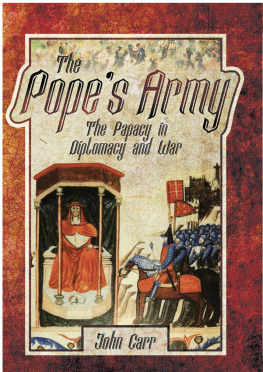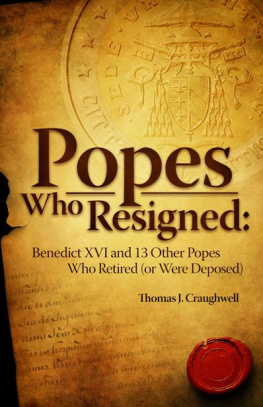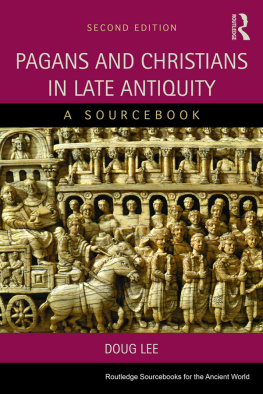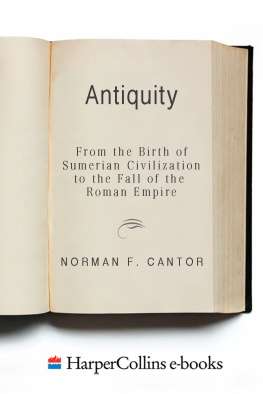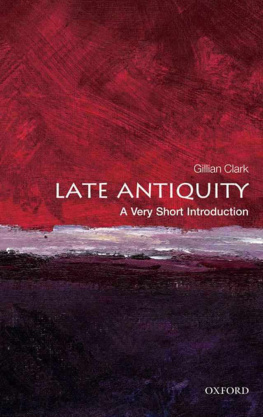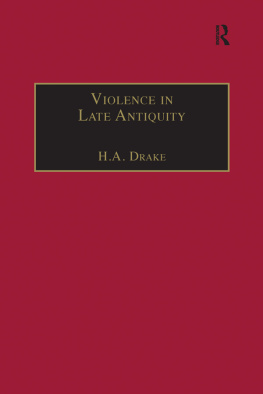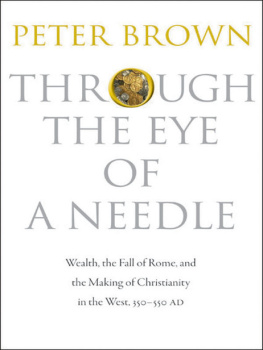The Church in the World
Surrounded as they were by physical reminders of its glorious past, pride in their city came naturally to the people who lived in Rome during late antiquity. Yet such a feeling was tempered by nostalgia, for whereas it was believed in the sixth century that someone who climbed the Capitol would see the works of human skill overcome, it was clear that the citys best days were behind it. Construction of the monumental buildings that so impress visitors to Rome to this day came to a halt. In the fourth century officials were told not to erect new buildings but to devote attention to restoring old ones, and anyone who did erect new buildings was prohibited from using materials pilfered from the old. Towards the middle of the fifth century an emperor responded to the problem of people recycling material from public buildings in words that capture the mood of the time: great things are being ruined so that small things can be repaired. An author of the sixth century deduced from the ambit of the walls, the great bulk of the Colosseum, the size of the baths, and the large number of mills, that the population of Rome had once been much greater than it was in his time. And whereas most cities in the western part of the Empire were failing to hold their own during late antiquity, the decision of the emperor Constantine to establish a new city on the Bosporus, Constantinople, as a second capital early in the fourth century, and military needs that increasingly took emperors, and the political power that accompanied them, away from Rome, meant that decline was experienced with particular intensity there. Humiliatingly, the city that had once seen itself as the head of the world was briefly occupied by hostile armies twice during the fifth century.
In 410 a force led by Goths entered the city and sacked it over three days, lighting fires that made people think of those that had engulfed Troy when it was captured by the Greeks. Among other things, the assailants helped themselves to some of the easily portable wealth that was located within the churches of the city. In the following decades attempts were made to compensate for the losses. Pope Celestine (422432) responded to the fire that Goths had caused by presenting a church that another pope had erected a
Whatever reasons had prompted the emperor Constantine to become a supporter of the Christian church early in the fourth century, his unexpected decision turned out to be the most important single event in the history of that body. A faith that had made steady, but by no means spectacular, advances since a representative of the Roman state had handed its founder over to be crucified, and had suffered spasmodic and well-remembered bouts of persecution, suddenly found itself the recipient of official backing that would accelerate across the century until, by its end, the sacrifices and worship in temples that had formed the most public parts of the Empires religious life in preceding centuries had been declared illegal. More of the traditional beliefs survived than our sources for the period suggest, but the adoption of Christianity by the rulers of the Empire was one of the most important events in the history of the West. Nowhere was its impact more apparent than in the ancient capital of the Empire, for although the city saw little of Constantine, he undertook there a massive campaign to erect buildings worthy of the religion he had adopted.
Modern visitors to Rome take for granted the pre-eminence of S Peters among the basilicas of the city, and it was certainly larger than the cathedral, but Constantines perspective was different. Nearly half of the income from the endowments he provided the churches with went to the Lateran and the baptistery that was adjacent to it; thereafter, in descending order, came the basilicas of S Paul, SS Marcellinus and Peter, and S Peter. By and large the popes had had little to do with S Peters, which was a considerable distance from the Lateran and thought of at the end of the century as being a haunt of drunken people remote from the concerns of the bishop. Donations made by pope Hilary to various churches in the second half of the fifth century suggests how their relative importance was viewed at that time: the Lateran and its baptistery were treated the most generously, and thereafter the basilicas of S Laurence, S Peter, and S Paul, in that order. The prominence of the basilica of S Laurence may answer to the growth that his cult was experiencing during that period, but Constantine had endowed the church poorly and with properties in its immediate neighbourhood, and Hilary may have seen himself as correcting an oversight. During this period the popes, like Constantine, invested S Peters with less importance than might have been expected.
Yet a powerful current was running that would undermine the central place of the cathedral, for the personal connection people felt with the martyrs was pulling against it. Today we unthinkingly refer to the basilica erected in honour of Peter as S Peters, but the terminology of our chief source for Constantines undertakings describes him building not S Peters basilica but a basilica for S Peter, and it uses similar language for churches dedicated to other saints. In the same way, it describes later rulers as making donations to S Peter. Such language conveys a sense of someone doing something on behalf of another person, perhaps one who was admired and whose goodwill was being sought. A bishop well experienced in the ways of rulers commented that kings had become suppliants and martyrs patrons, thereby inverting the customary relations between rulers and those they dealt with. So it was that, when the emperor Honorius entered Rome in triumph early in the fifth century, he was described as choosing to kneel at the memorial of the fisherman rather than the temple of the emperor, as the nearby mausoleum, now known as the Castel SantAngelo, that had been built for the emperor Hadrian in the second century was referred to. When Augustine enquired in a sermon as to whether an emperor visiting Rome first went to the tomb of Peter or the nearby temple of Hadrian, he did not feel it necessary to answer the question, whereas in the distant East John Chrysostom knew that emperors, consuls, and generals visited the tombs of the fisherman and the tentmaker, as he referred to Peter and Paul respectively. The practice of emperors was later imitated by kings who tried to present themselves in an imperial guise, so that when the Gothic king
Not surprisingly, emperors and members of their families wanted to be buried in close proximity to the remains of the martyrs. In Constantinople, emperors wished to be buried at the church of the Holy Apostles so they would not be separated from the remains of those who were thought to be the gatekeepers of heaven and the sovereigns of Christian society. In Rome, Constantines mother Helena was believed to have been buried in a mausoleum adjacent to the church of SS Marcellinus and Peter, and his daughter Constantia was laid to rest near the church she had built for the virgin martyr Agnes. They, and doubtless other, less well-known members of the laity, were using the martyrs in a way that made sense to them, and we may see here signs of a distinctive lay piety that could be practised with some degree of independence from the clergy. It does not follow from this that the basilicas erected in honour of Peter and the other martyrs were separate from the liturgical life of the city, for the gifts that Constantine made to S Peters indicate that he expected the Eucharist to be celebrated there, and indeed late in the fourth century it was the only church in Rome where mass was celebrated on Christmas Day. Whereas popes later came to celebrate the sacrament in other churches on Christmas Day, it seems to have been taken for granted that Charlemagne would have gone to S Peters when he went to church on that day in 800. But lists of the priests serving in Rome that identify the church in which each one served fail to mention any as being attached to S Peters or the other great churches built in honour of the martyrs, which makes it likely that, for all its grandeur, the basilica lacked a clerical establishment that would have allowed the Eucharist to be celebrated regularly in it, and as we shall see special arrangements had to be made for priests to be present at the major basilicas of the martyrs to conduct baptisms.




